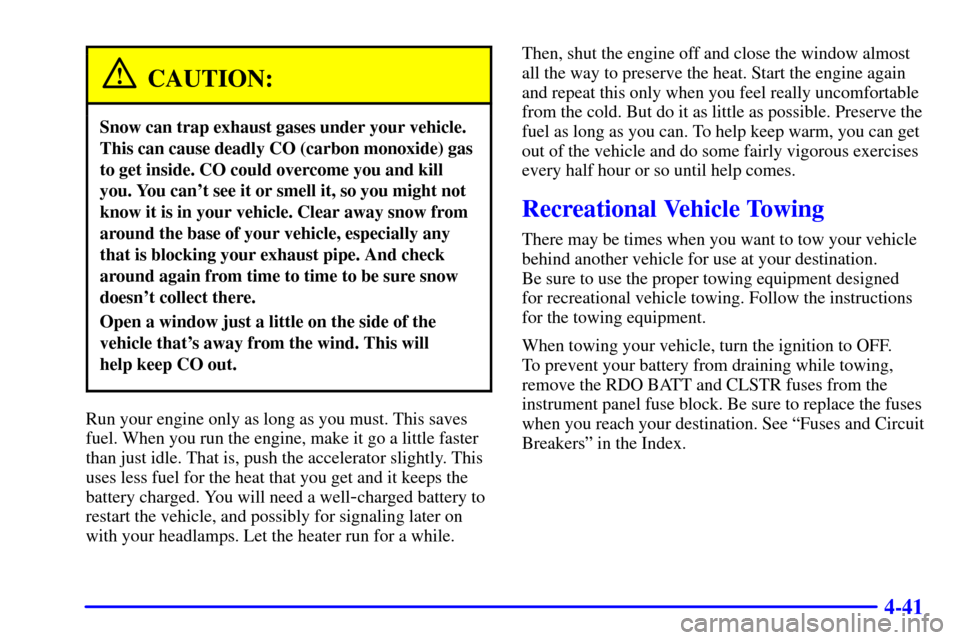Page 2 of 448
Courtesy
Transportation
Every
2001 Blazer
under warranty is
backed with the
following
services:1-800-CHEV-USA
(For vehicles purchased in Canada,
call
1-800-268-6800)
that provides in an emergency:
Free lockout assistance
Free dead-battery assistance
Free out-of-fuel assistance
Free flat-tire change
Emergency towing
®
1-800-CHEV-USA
(For vehicles purchased in Canada,
call
1-800-268-6800)
Page 150 of 448

2-82
3. Using both hands, press the hand-held transmitter
button and the desired button on the HomeLink
Transmitter. Continue to press both buttons
through Step 4.
4. Hold down both buttons until you see the red
light on the HomeLink Transmitter flash rapidly.
The rapid flashing indicates that the HomeLink
Transmitter has been programmed. Release both
buttons once the light starts to flash rapidly.
If you have trouble programming the HomeLink
Transmitter, make sure that you have followed the
directions exactly as described and that the battery in the
hand
-held transmitter is not dead. If you still cannot
program it, turn the hand
-held transmitter end over end
and try again. The HomeLink Transmitter may not work
with older garage door openers that do not meet current
Federal Consumer Safety Standards. If you cannot
program the transmitter after repeated attempts, refer to
ªTraining a Garage Door Opener with Rolling Codesº
later in this section or contact the manufacturer of the
unit at 1
-800-355-3515.
Be sure to keep the original hand
-held transmitter
in case you need to erase and reprogram the
HomeLink Transmitter.Canadian Owners: During programming,
the hand
-held transmitter may automatically stop
transmitting after one or two seconds. In this case, you
should press and re
-press the button on the hand-held
transmitter every two seconds without ever releasing the
button on the HomeLink Transmitter. Release both
buttons when the indicator light on the HomeLink
Transmitter begins to flash rapidly.
Operating the Transmitter
Press and hold the appropriate button on the
HomeLink Transmitter. The indicator light comes on
while the signal is being transmitted.
If the hand
-held transmitter appears to program the
HomeLink Transmitter but does not open your garage
door, and if the garage door opener was manufactured
after 1996, the garage door opener may have a ªrolling
codeº system. A rolling code system changes the code
of the garage door opener every time you open or close
the garage door.
To determine if you have this system, press the button on the
HomeLink Transmitter that you have programmed already.
If the indicator light flashes rapidly for one or two seconds,
then turns solid, the garage door opener has a rolling code
system. In a rolling code system, the garage door motor
head unit must be trained to the HomeLink Transmitter.
Page 257 of 448

4-41
CAUTION:
Snow can trap exhaust gases under your vehicle.
This can cause deadly CO (carbon monoxide) gas
to get inside. CO could overcome you and kill
you. You can't see it or smell it, so you might not
know it is in your vehicle. Clear away snow from
around the base of your vehicle, especially any
that is blocking your exhaust pipe. And check
around again from time to time to be sure snow
doesn't collect there.
Open a window just a little on the side of the
vehicle that's away from the wind. This will
help keep CO out.
Run your engine only as long as you must. This saves
fuel. When you run the engine, make it go a little faster
than just idle. That is, push the accelerator slightly. This
uses less fuel for the heat that you get and it keeps the
battery charged. You will need a well
-charged battery to
restart the vehicle, and possibly for signaling later on
with your headlamps. Let the heater run for a while.Then, shut the engine off and close the window almost
all the way to preserve the heat. Start the engine again
and repeat this only when you feel really uncomfortable
from the cold. But do it as little as possible. Preserve the
fuel as long as you can. To help keep warm, you can get
out of the vehicle and do some fairly vigorous exercises
every half hour or so until help comes.
Recreational Vehicle Towing
There may be times when you want to tow your vehicle
behind another vehicle for use at your destination.
Be sure to use the proper towing equipment designed
for recreational vehicle towing. Follow the instructions
for the towing equipment.
When towing your vehicle, turn the ignition to OFF.
To prevent your battery from draining while towing,
remove the RDO BATT and CLSTR fuses from the
instrument panel fuse block. Be sure to replace the fuses
when you reach your destination. See ªFuses and Circuit
Breakersº in the Index.
Page 279 of 448
5-5
CAUTION:
Fans or other moving engine parts can injure you
badly. Keep your hands away from moving parts
once the engine is running.
5. Check that the jumper cables don't have loose or
missing insulation. If they do, you could get a shock.
The vehicles could be damaged too.
Before you connect the cables, here are some
basic things you should know. Positive (+) will go
to positive (+) and negative (
-) will go to a heavy,
unpainted metal engine part. Don't connect
positive (+) to negative (
-) or you'll get a short that
would damage the battery and maybe other parts too.
And don't connect the negative (
-) to negative (-).
6. Connect the red
positive (+) cable to
the positive (+) terminal
of the vehicle with the
dead battery.
7. Don't let the other
end touch metal.
Connect it to the
positive (+) terminal
of the good battery.
Page 280 of 448
5-6
8. Now connect the black
negative (
-) cable to
the good battery's
negative (
-) terminal.
Don't let the other end touch anything until the next
step. The other end of the negative (
-) cable doesn't
go to the dead battery. It goes to a heavy, unpainted
metal part on the engine of the vehicle with the
dead battery.
9. Attach the cable at least
18 inches (45 cm) away
from the dead battery,
but not near engine parts
that move. The electrical
connection is just as
good there, but the
chance of sparks getting
back to the battery is
much less.
10. Now start the vehicle with the good battery and run
the engine for a while.
11. Try to start the vehicle with the dead battery. If it won't
start after a few tries, make sure all connections are
good. If it still won't start, it probably needs service.
Page 281 of 448
5-7
12. Remove the cables in reverse order following the
diagram and directions below to prevent electrical
shorting. Take care that they don't touch each
other or any other metal.
Jumper Cable Removal
A. Heavy, Unpainted Metal Engine Part
B. Good Battery
C. Dead BatteryTo disconnect the jumper cables from both vehicles,
do the following:
1. Disconnect the black negative (
-) cable from the
heavy, unpainted metal engine part on the vehicle
with the dead battery.
2. Disconnect the black negative (
-) cable from the
negative (
-) battery terminal on the vehicle with the
good battery.
3. Disconnect the red positive (+) cable from the
positive (+) battery terminal on the vehicle with the
good battery.
4. Disconnect the red positive (+) cable from the
positive battery terminal of the other vehicle.